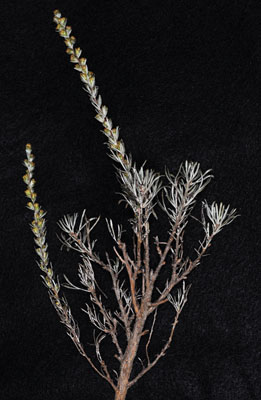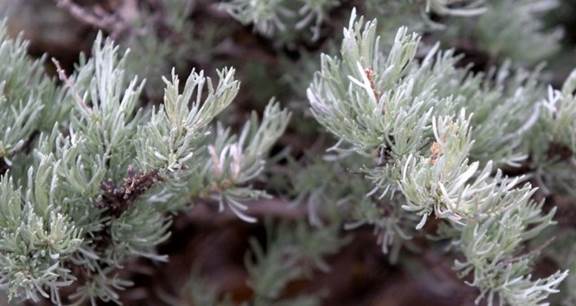………in [this] infernal soil nothing but that fag-end of vegetable creation, “sage-brush,” ventures to grow…When crushed, sage-brush emits an odor which isn’t exactly magnolia and equally isn’t exactly polecat–but it is a sort of compromise between the two.–letter to Jane Clemens from Samuel Clemens, 1861
Stiff sagebrush, also known as scabland sagebrush is a small shrub found in the Columbia and Snake River drainages and the northern end of the Great Basin, extending through portions of Idaho, central and eastern Oregon, and eastern Washington. Earlier reports that it extended into Montana were incorrect. It grows up to 12-16 in tall and has a very pungent aroma with thick, rigid, and somewhat brittle branches. The leaves are ¾ to 1.5 inches long, silvery green, deeply divided into three or five narrow lobes, and deciduous. It is generally found between 700 and 6,000 ft in elevation (this varies on the reference) on thin, rocky basaltic soils and in areas limited to an annual rainfall of 9 – 13 inches.
This is a pretty hardy plant able to eke out a living where other shrubs cannot survive – including other sagebrush. Typically it is found with Sandberg’s bluegrass or other arid land grasses able to grow in the rocky soil. Stiff sagebrush is able to survive fire well even though it appears to have a limited ability to re-sprout. It’s thought that the widely spaced plants and lack of ground cover on the rocky soil do not carry fire well and help preserve it. Plants grow slowly and take 2-4 years to reach their full height. Artemisia – the Greek goddess of forests and hills; and rigida – rigid or stiff.
Flowers bloom in the late summer and through autumn, late August through early October, with the seeds ripening in later October and November. The flower heads are bell-shaped and a quarter inch long. The flowers are wind pollinated and the seed is dispersed by the wind – if you have spent any time in eastern Washington you can attest to this – and seedlings sprout the following spring. The amount of seed produced by stiff sagebrush is relatively low compared to other sagebrush species.

Depending on the location, it can be the first shrub that appears after snowmelt and can offer some early season wildlife browse for elk, mule deer, and bighorn sheep. Sage grouse also are known to forage on young leaves. In a study done in the 1960’s in over 600 trap-nights (number of traps x number of nights) only one species of small mammal – the aptly named sagebrush vole – was captured among stiff sagebrush stands. So these sparse habitats aren’t exactly a mecca for wildlife.

The above photo is a typical example of stiff sage habitat – widespread plants, rocky soil, few other shrubs, and Sandberg’s bluegrass. This is atop the north ridge bordering Umtanum Creek, which flows into the Yakima River, south of Ellensburg. I’ve seen horned larks nesting under the base of these shrubs and on the nearby Yakima Training Center came across sage sparrows nesting in stiff sagebrush, though they much prefer larger sagebrush.
I’ve come up here a few times during the Perseid meteor showers in late summer to spend the night. Once me, Connie, and my daughter Chloe wandered up the ridge with just sleeping bags in the pack and some food/drink for the evening. Wandering around the stiff sage it was obvious this was not the place to lay down your bag – rather, you would look for the larger sagebrush species (big sagebrush – background in photo) which indicated deeper soils and likely wind-deposited sand, which made for a nicer bed from which to watch the meteor show. We settled down at dusk listening to the coyotes yip-yap away, ready for the evening show.
